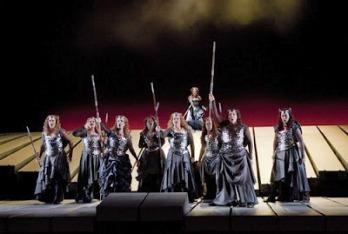
Ride of the Valkyries (Ken Howard / Met Opera)
A Tale of Two Tenors
I did not yet discuss the Ring cycle’s plot or story line – and there’s good reason for that. To put it simply, it’s complicated. Besides, Wagner provided the listener with an ongoing recapitulation of events, which he placed in strategic guises throughout the four operas. These recaps or commentaries can be heard in the characters of the Rhine maidens, the Norns, Erda the Earth Goddess, the Valkyrie Brünnhilde, her sister Waltraute, Siegmund, Sieglinde, their son Siegfried, Alberich, Hagen and Wotan, the head god himself, among numerous others.
Most knowledgeable Wagnerians dote on these extra-musical exercises in repetitiveness, while others loathe and despise them as long-drawn-out time wasters. Whichever camp you find yourself in, one has to admit that they do help to fill in the finer points of the drama and, for the serious opera fan, provide needed background about what took place in the past or will happen in the future.
Briefly, then, the dwarf Alberich is spurned by the Rhine maidens, after which he renounces love and steals their gold (nice guy!), from which he forges a Ring of power that will allow the wearer to rule over all things (shades of Tolkien’s Lord of the Rings be damned). That’s it in a nutshell. Of course, I’ve oversimplified matters in the extreme, but basically Alberich goes on to lose the Ring, places a mighty curse on the object, and never gets it back.
The elusive Ring, on the other hand, acquires various owners, including Wotan, the giant Fafner (who in order to guard it transforms himself into a dragon), Siegfried, Brünnhilde, and Siegfried again, then Brünnhilde again, and finally back to the Rhine maidens from whence it originated. Oy vey!
The late raconteur Anna Russell gave many a hilarious insight into this subject, which anyone can check out on YouTube to their heart’s content, they are definitely worth the time and trouble. Anyway, on to the next installment: Die Walküre.
The role of Siegmund is not a particularly long or strenuous one, compared to, say, Tristan or Siegfried. It lies comfortably within most dramatic tenors’ range; in fact, it may be too low for some voices. But whatever the case, the Met’s April 13 performance gave us two, count ‘em, two singers for the price of one.
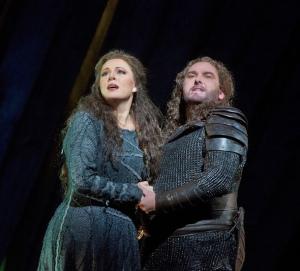
Martina Serafin & Simon O’Neill (theclassicalreview.com)
Blame a severe allergy attack (and the ridiculously high pollen count) for sidelining the scheduled Siegmund, New Zealand-born Simon O’Neill. Curiously, just a few weeks before, at the Saturday La Traviata broadcast, Met General Manager Peter Gelb announced that Placido Domingo had had an allergy attack as well, but that he decided to soldier on regardless. As his name indicated, the unfazed Señor Placido managed to get through the afternoon relatively unscathed. Not so Mr. O’Neill.
Although he appeared to start off well, it soon became apparent that O’Neill was incapable of continuing with the performance. He was replaced, in fairly short order (and in discrete fashion), in mid-act by another New Zealander, the young Andrew Sritheran – for all we knew might it have been Slytherin, which is one of the four houses at Hogwarts School of Witchcraft and Wizardry. The Met and Mr. Gelb could have used some of that old black magic to pull this trick off. Fortunately for them, the Kiwi native proved his mettle by overcoming the Ring’s curse and went on to a respectable if not exactly stellar debut. It may not have been the best sung or richest Siegmund in memory, but Sritheran helped save the day – and the Met’s terribly expensive cycle, at that.
Another radio debutante, soprano Martina Serafin, made a commendable stab at Sieglinde, her third act cry of “O hehrstes Wunder” at the news of her pending pregnancy with Siegmund’s child soaring effortlessly over the vast Met auditorium – a memorable moment. In other areas, Serafin’s soprano sounded warm and inviting, like the hearth in Hunding’s hut. She and Sritheran combined forces to give a rousing rendition of the Act I duet, where they finally discover they are, in fact, brother and sister, in another of those Wagnerian happenstances.
Sieglinde’s husband Hunding was taken by bass Hans-Peter König, who seemed almost too good-natured and benign to be a villain. It was all part of the act, though, and soon his smoothness of tone turned rough around the edges as he eyed the handsome Siegmund (and how much he resembled his wife). Hunding is a short part, but König succeeded in conveying the character’s gruffness. Still, there is decidedly more to the huntsman than Hans-Peter showed. Blame the direction and lack of acting space for that. I can recall the young and brutish Mattias Hölle, in Harry Kupfer’s “Road to History” Ring production at Bayreuth, and how he sunk his teeth into this role. The looks of disdain he gave both Siegmund and Sieglinde were enough to melt the wooden planks off the walls, whereas König was as placid as an ox.
Close Encounters of the Operatic Kind
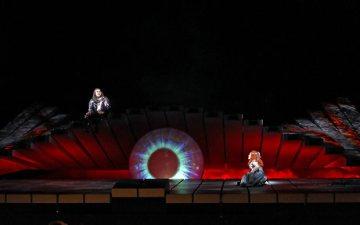
Wotan’s “Eye” (nytimes.com)
Act II forms the musical crux of the drama, a rather byzantine set of situations that the lead characters – principally that of Wotan – have foisted upon themselves. Mark Delavan once again sang the head god, in a continuation from the previous broadcast of Das Rheingold. He has the requisite dark timbre and gravely low notes the part calls for, which is more than I can say for Bryn Terfel, his predecessor in the role when this production was new. Terfel is a fine singer, but his voice is much too bright for Wotan; whereas Delavan has the proper weight and substance, as well as the “chops,” to make an impact in his mid-act monologue, wherein Wotan looks both backward and forward in time, represented downstage by a mirror-like object (supposedly, a substitute for the god’s missing eye).
What with Wotan’s gloomy reflections and thoughts of “Das Ende” (“The end”), punctuated by the lowest instruments in the brass (the so-called Wagner tubas), this is the most gripping portion of the Ring, in my estimation, requiring a singing actor of tremendous range and versatility. Delavan’s German needed to be more pointed, and certainly more alert to the text, than it was here. In later productions, I hope he develops his enunciation skills further, for what Wotan says in this act is of paramount importance and influence in the later Ring operas.
Notwithstanding this criticism (and I’m exceedingly picky when it comes to my Wagner), Delavan is well on his way toward becoming a truly great Wotan and Wanderer. He shook the rafters with his angry outbursts at daughter Brünnhilde’s disobedience of his will (a Schopenhauer influence), and his scornful dismissal of Hunding, with a half-growled, half-garbled, “Geh, geh!” (“Go, go!”), evoked fond memories of Canadian George London in the role. He ended the opera with a long-held note on the last word of the phrase, “Wer meines Speeres Spitze fürchet durschreite das Feuer nie” (“He who fears the point of my spear shall not pass through the fire”).
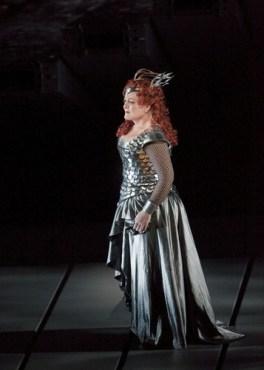
Deborah Voigt as Brunnhilde (3-bp.blogspot.com)
On the distaff side, soprano Deborah Voigt repeated her womanly Brünnhilde from last season. Her Valkyrie was sympathetically vocalized as well as acted, and she’s improved her interaction with Wotan to a noticeable degree – no doubt her experience in the part, which lies more comfortably in her vocal range than the later Brünnhilde’s do, helped matters a lot.
I still hold the conviction that this role is one Ms. Voigt should avoid in future Met assignments. She’s done everything humanly possible to overcome the fact that she does not really possess a Brünnhilde-type voice. And by that, I mean the clarion high notes, the emotional release necessary to make this character come alive on the stage.
To state my case, the current staging of this production serves as more of a hindrance in that department than any of the singer’s personal attributes or deficiencies. My view, then, will be borne out in the next post concerning Götterdämmerung. Voigt did make a tolerable meal out of her “Hojotoho” war cries at the start of the act (although effortful, the high B’s were all there, intact and ready for action), but beyond that her emotionally wrought exchanges with her father, and in particular the lengthy Todesverkündigung (“Annunciation of Death”) sequence with Siegmund, brought out the character’s warm and feminine sides — her basic humanity, as it were. It’s still treacherous out there on those planks, as they creaked and groaned to upstage the singers.
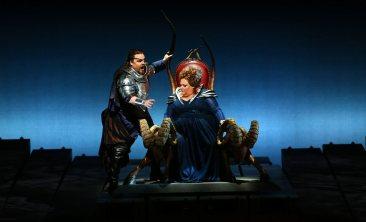
Mark Delavan & Stephanie Blythe (nytimes.com)
Stephanie Blythe’s formidable Fricka is another known quantity, a powerfully done and implacable moral entity. Blythe could mow any Wotan down with her looks alone; that she has a voice to go with it made her Fricka a force to be reckoned with.
Unfortunately, outside of this one confrontation, Wagner gave this character too little to sing and not enough scenery to chew. Any artist undertaking this role needs to make the strongest impression possible within a relatively short time span, much like Hunding and, later on in the cycle, Waltraute, the Woodbird and Alberich.
Maestro Fabio Luisi continued to shine in this, his best conducted Ring performance of the three that I heard. The eight Valkyries, too, performed over and above their brief Valhalla duties in Act III, even earning the audience’s applause for their “hobby-horse” antics atop those 24 movable planks – ah, the terrors of modern, hazardous staging… They were better off than the Rhine maidens, who were forced to dangle some 20-30 feet above the Met stage in the opening scene of Rheingold. No amount of the Nibelung’s horde is worth putting up with that.
There’s more to come with my next post. Stay tuned!
(To be continued…)
Copyright © 2013 by Josmar F. Lopes

